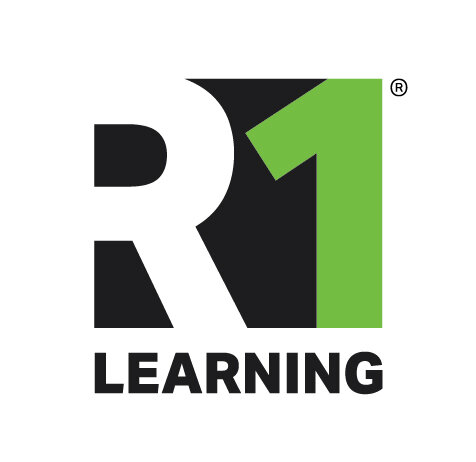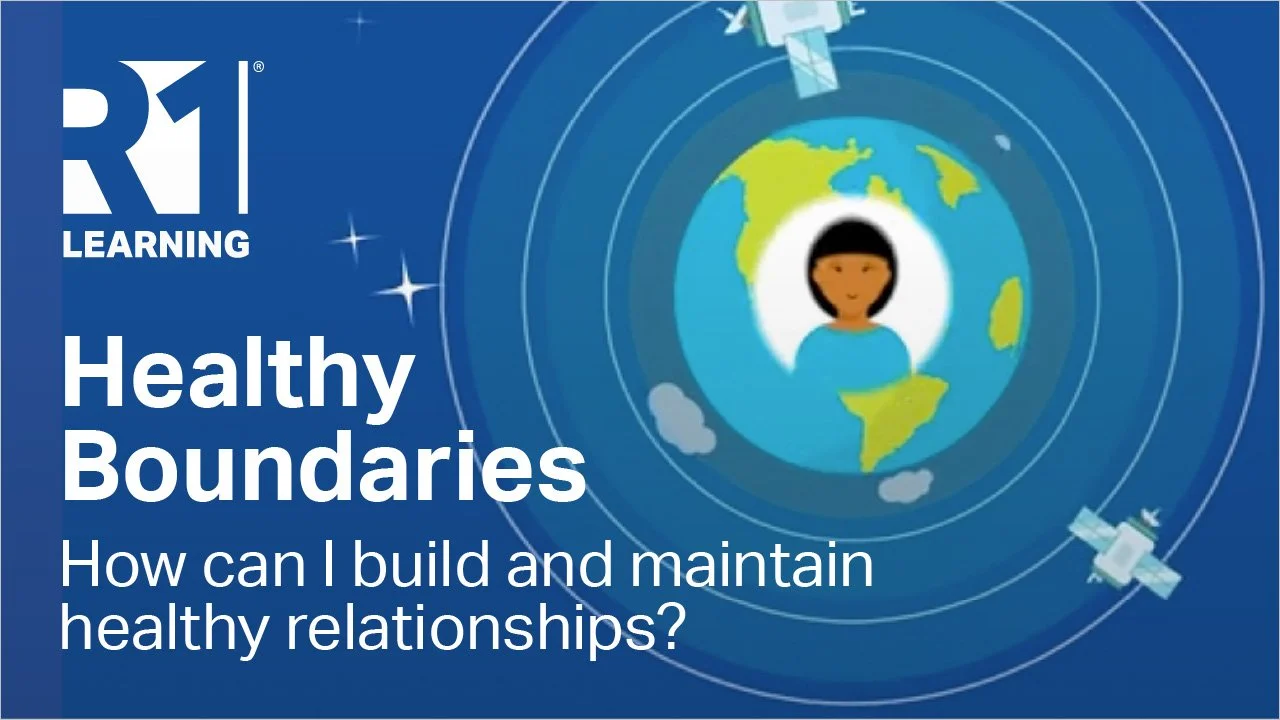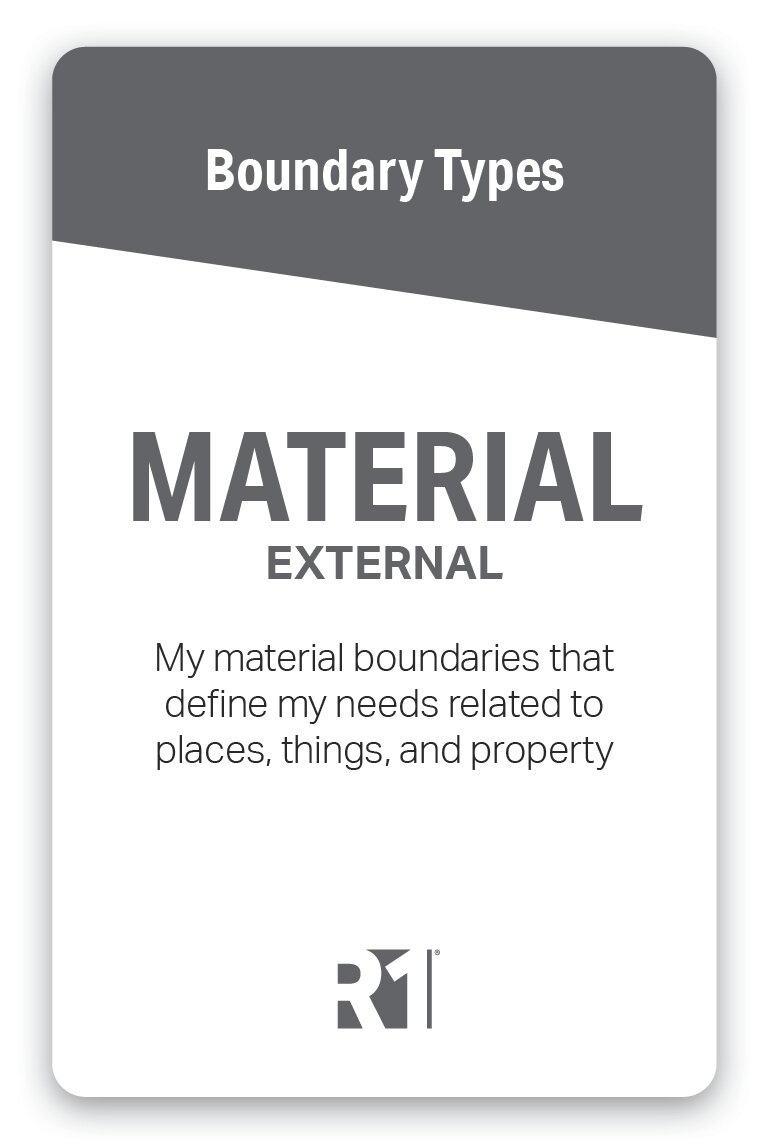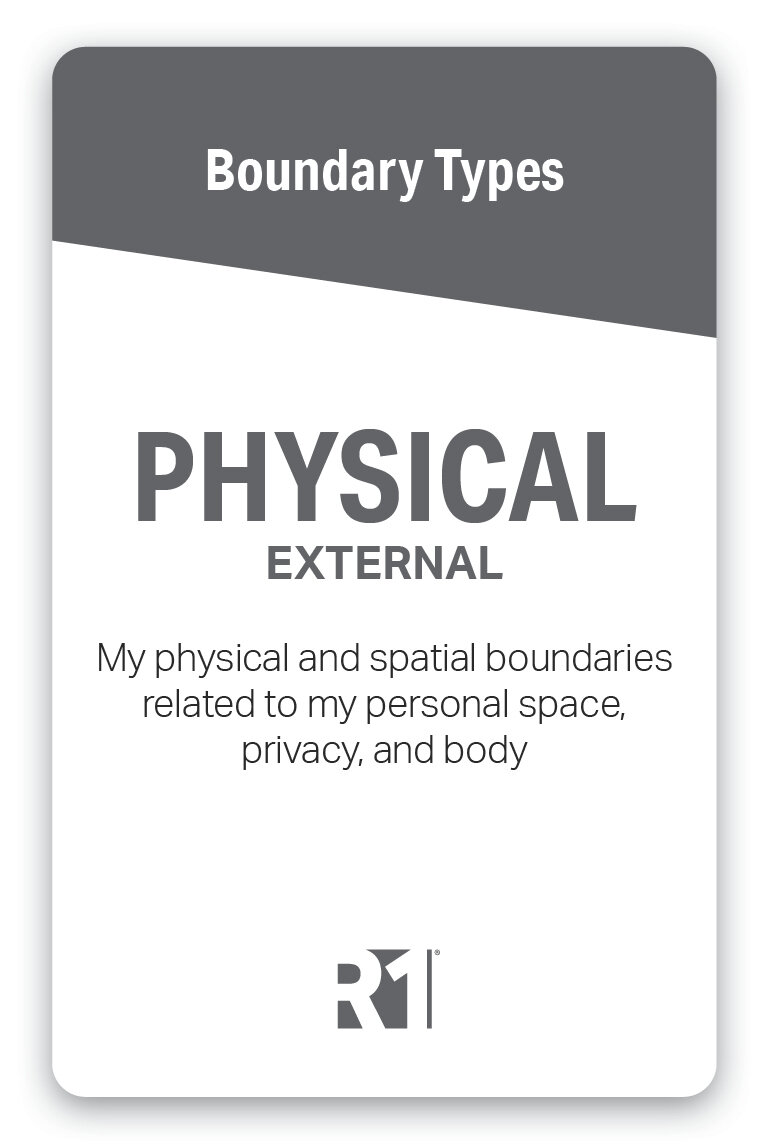8 Boundary Types for Building Healthy Relationships – Which Are Most Difficult for Me?
Over the last year, we’ve been sharing our product roadmap and letting everyone know what’s coming. Healthy Boundaries and Emotions & Feelings have far and away been the two most popular topics on our Discovery Cards waiting list. Thankfully, both are being released this next month.
Healthy Boundaries is the topic of today’s post. The first in our category of The 101s. I have personally learned a lot about myself during the development of this Discovery Cards deck. Building healthy boundaries has always been a struggle for me. In relationships, I’ve overstepped or been hurt when others have drawn limits that were different from my own. I have over committed and then felt badly when I let other people down. I’ve crossed lines in all areas of life – with relationships at work, family and friends, others’ feelings, food, and alcohol. My major learning has been that healthy boundaries keep me healthy and safe in so many ways, especially emotionally. They also allow me to respect the health and safety of others, allowing them their space to grow and gain the emotional stability they need. I am learning to swim in my own lane and allow others to swim in theirs. It hasn’t always been easy as my emotions and feelings often come into play and get in the way. I am learning that I don’t have to go into others’ lanes that may be unhealthy for me or allow them to come into mine. Just because something or someone is in my environment doesn’t always warrant exploration, experimentation, or my involvement. In most cases with people, what others are thinking, feeling, or doing has nothing to do with me and is actually none of my business. I thought that boundaries would limit me, but instead, I’ve gained much more freedom, safety, and emotional well-being when they are present.
Discovering Boundary Management
In developing the Healthy Boundaries Discovery Cards deck and Professional Kits, we landed on two key models to help individuals think about healthy boundaries and discover how well they manage them – Boundary Management Practices and Boundary Types. In our research, we found lots of boundary management behaviors that are key to success, but no simple model that highlighted boundary management practices. The behaviors we identified could be clearly and easily bucketed into the five practices highlighted on the poster to the right. We’ll go into more detail on the Boundary Management Practices in a future post. Today, we want to focus on the first step of the process – DEFINE boundaries.
First, let’s clarify what we mean by relationships in our post title. A relationship is the state of connectedness between two or more objects, concepts, or people.
It is important to recognize that this connectedness is broader than just people. Think about relationships as meaning your environment – basically the world around you, including all of the people, places, things, and situations in your life as identified on the outside of the circle model on the poster. We want to highlight such environments as your living space or home, food, property, your body, sex, the Internet, and places like schools, workplaces, or community spaces. Even what happens in the conscious or unconscious realm of our minds – including thoughts, feelings, and beliefs – are part of this environment.
Explore R1 Discover — Interactive Engagement Tools
Second, let’s define what we mean by boundaries:
Defining 8 Boundary Types
In daily life, people often speak vaguely about boundaries. In many instances, the specific meaning is not clear for the communicator or for the listener. We often hear things like, “I just need to build better boundaries” or “they are overstepping my boundaries.” That’s a start, but what are we really talking about here? How can someone help me if I can’t clarify exactly what is making me feel disturbed, unhealthy, or unsafe? How can I help and support someone else if I do not understand what they are referring to? Vocabulary is so important for individuals when practicing healthy boundary management. Without a broad vocabulary, it can be very difficult to express what one is thinking and feeling and make better choices as a result.
Definition: A boundary is the line or edge that marks the limits of something.
Below we define 8 Boundary Types in two categories and a few questions to explore to get us started. We’ve defined them in the first person to make them more relatable. These are also the definitions we use in our Discovery Cards decks, Facilitator Guides, and Group Kits.
External Boundary Types: External to my mind – outside of my thoughts, feelings, and beliefs
Behavioral – My behavioral boundaries that define what I will and will not do in terms of my actions. Examples include behaviors such as:
eating
using substances
shopping
following or bothering other people
working long hours
Material – My material boundaries that define my needs related to places, things, and property. Examples include:
clothes
cars
toothbrushes
time
money
Physical – My physical and spatial boundaries related to my personal space, privacy, and body. Examples include:
hugging
touching
polluting (noise, smell, smoke, etc.)
pushing
grabbing.
4. Sexual – My sexual boundaries related to my comfort level with physical intimacy. Examples include:
choices around the act of sex (e.g. with whom, where, when, how, frequency)
protection
sexual partners
sexual stimuli – what arouses me
touching
Social – My social boundaries related to social rules and societal norms. Examples include:
cultural customs
family rules
friendship understandings
societal laws
work codes of conduct
Internal Boundary Types: Internal to my mind – my thoughts, feelings, and beliefs
Emotional – My emotional boundaries related to my emotions and feelings. Examples include boundaries around:
expressing healthy anger
feeling fear
expressing guilt
feeling and embracing joy
feeling and expressing love
feeling shame
feelings of confidence or strength
Mental – My mental boundaries related to my thoughts, beliefs, and values – note that there is a lot to consider here. Examples include:
choices
expectations
ideas
opinions
politics
Spiritual – My spiritual boundaries related to my beliefs and my vision of God or a higher power (or lack thereof). There is an extensive list here too that includes:
religious or spiritual customs
religious traditions
spiritual practices
spiritual beliefs
spiritual or religious rituals
Helpful, right? Building a taxonomy for boundaries broadens their meaning while at the same time helping individuals communicate something more specific within this broader context. Without this vocabulary, it can be difficult to express oneself effectively.
Let’s put these new boundary type distinctions into practice. Here are two scenarios to explore:
Scenario 1–You: Think about a situation you are experiencing right now that may be triggering your emotions and feelings in some way. Write it out with as much detail as you can. Answer the following questions:
Look at the list of boundary types above. Which ones have you established?
Which ones are missing that you think would be helpful to build?
If you could establish or strengthen one boundary type, which would it be?
What will be the benefit for you, and others, if you establish or better manage this boundary type?
What is one action you can take today to do this?
Who can you ask for help and support?
Scenario 2–A family member, friend, or client you are working with: Identify an individual dealing with a situation that may be triggering or emotionally unsettling in some way. Answer the following questions:
Who are you thinking about and why?
What person, place, thing, or situation is causing an issue or problem for this person?
Which boundary types do you think are missing or not being managed effectively? Why?
How could this person build or strengthen these boundary types?
What would be one positive benefit if these boundary types were in place today?
What one or two questions can you ask this person to support them in building healthy boundaries?
Were these boundary types definitions helpful in thinking about yourself, this individual, and answering the questions? I’ve found them to be incredibly helpful in giving me a way to think about boundaries. As I mentioned at the beginning of this post, boundary conversations have become an integral part of my conversations with family, friends, and work colleagues. More importantly, these 8 Boundary Types have given me the vocabulary and a framework to make healthier choices in every area of my life.
References
Cloud, Henry. Townsend, John. Boundaries. Grand Rapids, MI, Zondervan, 2002
Freundlich, Lawrence. Mellody, Pia. The Intimacy Factor. New York, New York. Harper Collins Publisher, 2004.
Mellody, Pia. Miller, Andrea Wells. Miller, J. Keith. Facing Codependence. New York, New York. Harper Collins Publisher, 2003.
Whitfield, Charles. Boundaries and Relationships. Deerfield Beach, FL, Health Communications, Inc. 2010.
Copyright 2023 R1 Publishing LLC / All Rights Reserved. Use of this article for any purpose is prohibited without permission.
Healthy Boundaries Discovery Cards and Group Kits – Tools for Practice
Integrating these tools into your groups will allow individuals to build their vocabulary, think about these concepts concretely, and put their choices into action. Visit the R1 Store and order our Healthy Boundaries Discovery Cards Group Kits. The cards are an amazing tool for exploring Healthy Boundaries with individuals or groups.
This is just the beginning of our boundaries discussion. We will be exploring 5 Boundary Management Practices in an upcoming post so stay tuned.
Want to keep the momentum going? Here’s how:
Share this blog post with others. (Thank you!)
Start a conversation with your team. Bring this information to your next team meeting or share it with your supervisor. Change starts in conversations. Good luck! Let us know how it goes.
Visit www.R1LEARNING.com to learn more about R1, the Discovery Cards, and how we’re creating engaging learning experiences through self-discovery.

















